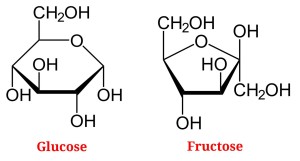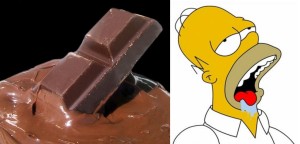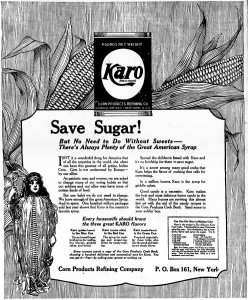
Sugarloaves from the Berlin Sugar Museum.
(In other news: Berlin has a sugar museum.)
Ah, Sugar!
You know me: I can’t resist a controversial topic. (Sorry.) (Cain’t hep it.)
Right now, there’s a world of buzz about High Fructose Corn Syrup (HFCS), which is heavily used here in the Y’United States. Most soft drinks use it nowadays, as do many processed foods (read the labels; you might be surprised).
Is it healthy? Is it more or less dangerous than “regular” table sugar? Is it the same as table sugar?
Because I wanted to know for myself, I decided to look into it. I shall decipher all of that complex gibberish and render it (hopefully) (maybe) a bit more clearly.
As usual, you can thank me later.
If you’re in a hurry and want the bottom line: no, HFCS is not the same as table sugar … but it really doesn’t matter very much to your body long term. Read on.
 Simple Sugars
Simple Sugars
If you or a loved one has been struggling with diabetes — with “high blood sugar” in general — you’ve certainly heard of glucose (sometimes called “dextrose”). This is a simple, single-molecule sugar that appears everywhere in nature.
Plants make it via photosynthesis, just as you learned in school, combining carbon dioxide and water, and releasing oxygen for us to breathe.
Plants frequently chain the glucose molecules together, though, forming starch. Your digestive system will quickly break those chains into individual glucose molecules. Ask any diabetic: plain white bread can mess up the A1C as badly as eating candy. That’s why.
Another very common sugar found in nature is fructose. It has the same chemical formula as glucose (C6-H12-O6), but a slight rearrangement of the atoms causes your body to treat it differently. Speaking generally, glucose in the bloodstream is what your body uses for energy (with insulin … I’m keeping this simple). Fructose requires more work to be done by your liver.
There are other simple sugars (the geeks call them monosaccharides — “single sugars”), such as galactose, but we’ll focus on glucose and fructose here.
OTAY. That’s enough background.
 Sucrose
Sucrose
Now: what about sucrose — common table sugar? Those delightful white crystals that we pour on and in and over everything?
Sucrose is simply a molecule that contains one (1) glucose and one (1) fructose, kinda stuck together. It’s a relatively weak bond, but it makes a difference (hold that thought).
Some plants make sucrose naturally, including (of course) sugar cane and sugar beets. Boil the plants, process the juice, then bleach it, fold it, spindle it and mutate it and you eventually get … pure white table sugar. Pure sucrose.
The key is that the glucose and fructose are stuck together. That’s the reason why pure table sugar has a uniquely pure, sweet taste. It does happy things to your tongue. Most people also feel a cooling effect in the mouth (especially with finely-ground confectioner’s sugar, such as on powdered donuts).
Artificial and alternative sweeteners aren’t the same. Pure glucose or fructose by themselves, or stevia, or sucralose (Splenda brand), you name it: they may be sweet, but they don’t have quite the same taste.
If I were to stop now, the “sugar, not HFCS!” crowd would be pleased with me. We could live happily ever after. But now for some pesky science.
 Corn Syrup
Corn Syrup
Corn syrup, made from corn starch, is mostly glucose. Through a whole bunch of processing that involves enzymes from bacteria and fungi, you get common corn syrup (most Americans are familiar with the Karo brand).
If you process the glucose further with more enzymes, you can turn some of that glucose into fructose. Thus is born High Fructose Corn Syrup (HFCS), which is supposed to be just as sweet as table sugar.
(Note: older corn syrups such as Karo brand are not HFCS.)
It doesn’t taste the same, though. If you get your hands on a cola drink that’s made with sucrose, it has a more full-bodied taste. That’s the sucrose doing its usual number on your tongue. Regular corn syrup and HFCS can make a drink that’s just as sweet, but it still won’t feel the same in your mouth.
So, here’s the first point: HFCS is not equivalent to table sugar. Yes, it’s a blend of glucose and fructose — same as sucrose — but the molecules are split apart. They’re separate.
 Honey
Honey
For the remainder of this screed, I’ll give you my opinion based on a bunch of reading (wading through arguments) (stopping to rest periodically).
To give you a clue, fully-processed honey is primarily a mix of separate glucose and fructose molecules … just like HFCS. It’s not exactly the same; there’s a little sucrose in there, along with a small percentage of other things (including some nice anti-oxidants in many honeys), which is why most have a unique taste.
But chemically, HFCS is most like honey or invert sugar syrup (which has been used in baking for centuries): the fructose and glucose molecules are separated.
This is also why there’s a real problem nowadays with companies adulterating pure honey with HFCS. It’s a great way to stretch the more expensive honey and make more money. Your mouth won’t notice the difference — and more to the point, neither will many of the standard tests for honey purity.
(Ponder that last sentence for a moment. The classic, standard tests for honey purity can’t tell the difference.)
Some all-natural folks will brag endlessly about how they only use “pure honey” as a sweetener … not realizing that, to their bodies, it’s essentially the same as HFCS over the long term. (Again: yes, there may be antioxidants and other goodies in your honey, but the way the sugar content is treated by your body is no different from the way that HFCS is treated.)
 So: Healthier? No.
So: Healthier? No.
Now for the next point. We’re back to diabetics, who learn soon after their initial diagnosis what most people apparently don’t realize: any excess of carbohydrate is bad for you, period.
All sugars and starches will make your A1C go up … some less than others, some more, and fiber (among other things) seems to help. But at the end of the day, if you have diabetes, you are told to watch the white bread, white potatoes, corn and a million other things. No Coke or Pepsi, of course, but no plain bagels, either.
And here’s the final point. You might think that sucrose, being glucose and fructose that’s clumped together, would be “healthier.” Not really. Your digestive system breaks it down into separate molecules, anyway. You still get a load of both glucose and fructose as individual molecules.
The argument has been made that, since the body has to do more work to “split” sucrose, it’s a bit better for you. I’ll leave that up to you. The bottom line is that whether you consume white table sugar, HFCS or honey, your body must deal with glucose and fructose molecules. The benefits of one over the other pale in comparison to the damage done by too much sugar. Nuff zedd!
Just my opinion and worth precisely what you paid for it, but there you go. Click here to return to the main page, or use the menu.






